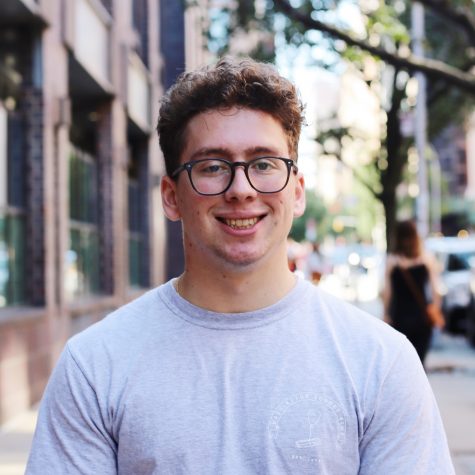NYU’s vegan, bike-riding, meal plan-having Chief Sustainability Officer Cecil Scheib spends his days trying to convince big names in university administration to better NYU’s impact on the environment.
And, largely, he’s successful. How? He’s learned a language administrators can understand — money.
Scheib was first hired in 2007, and since 2009, NYU’s carbon emissions have been reduced by 35%. He said this has saved the university $15 million.
“NYU’s sustainability program, overwhelmingly, has a fantastic business case,” Scheib said.
Every day, he works to sell the concept of a sustainable NYU. He has meeting after meeting with various NYU stakeholders ranging from students to Board of Trustees members. Sometimes, he’s pitching them a sustainability effort; other times, they pitch him.
In an interview with WSN, Scheib outlined three types of sustainability efforts. The first he called “easy wins” — things that immediately reduce costs but also increase sustainability, like buying less of a wasteful product. Second are instances where you have to “spend money to save money,” or where an initial investment leads to less spending over time.
Then there’s the third category.
“The third thing is things that don’t have any payback, but that are just the right thing to do,” Scheib said. “We don’t do a lot of the third category.”
Scheib’s seven-person team is tasked with making a university with more than 19,000 employees and 60,000 students more sustainable. What they’ve discovered is, often, the “right thing” is not enough for NYU administration.
But when the “right thing” can also save NYU money, they’re more likely to get the go-ahead. Examples are the university banning spending on plastic water bottles and making buildings more energy-efficient.
Perhaps the largest effort by the Office of Sustainability is their Climate Action Plan. Originally released in 2009, it set a course for carbon neutrality by 2040. Buildings make up over 96% of NYU’s emissions, so the plan focuses on reducing reliance on fossil fuels and increasing energy efficiency. After NYU passed its goal of reducing emissions by 30% by 2017, Scheib said the plan has since been updated to include a 50% reduction goal for 2025.
“In between now and 2040, we are going to touch every space on campus,” Scheib said. “The hard part is, it might only get that once. If we are going to renovate a building in 2025, we are not doing it again before 2040.”
A resolution by student activists from NYU Divest, passed in the University Senate last semester, set three goals for the university: 100% reliance on renewable energy by 2040, to sever ties with gas plants that rely on fracking and to completely divest from fossil fuels.
Although he says the goals are aspirational, Scheib thinks they are reasonable, too.
“Not only do I think it is achievable,” Scheib said. “I think the high level goals in the resolution, I think we must achieve.”
With state law requiring New York to get 70% of its electricity from renewable sources like wind, solar and hydropower by 2030 and shift entirely to carbon-free power a decade later, Scheib said NYU may be able to achieve Divest’s 2040 goal of sole reliance on renewable energy.
Scheib gets excited when he talks about renovating Rubin Residence Hall, where he says AC will be added while reducing carbon emissions, as was done in the 2013 renovation of Brittany Resident Hall.
Scheib said this would not result in increased cost to students, likely because — as with most of his initiatives — it already saves NYU a significant amount of money, albeit over time.
“I can advocate for an investment that will lower costs and in the long run, will actually make it cheaper for students,” Schieb said. He credits his ability to do so with NYU’s long-term vision for the buildings they own, as compared to building owners looking to flip properties.
However, a long-term vision that looks forward 10 or 20 years — Scheib said the university is already planning renovations for the mid to late-2020s — can make it harder for students to see results during their time at NYU.
“Not only are students not going to see it in four years,” Scheib said. “The students who are going to see it aren’t even here yet.”
Still, students can get involved in more immediate efforts, like GoGreen Week in the spring, when Scheib said NYU (global campuses that opt in included) will have a series of events focused on sustainability education, all organized by students. Occasionally, the university works with students more closely, like when NYU bought a semester’s worth of sustainable straws from SeaStraws, a student-run company.
The office has also recently released a transportation survey meant to help pinpoint issues in students’ commutes.
But trying to incorporate students’ input in other areas can be hard when the focus is profitability. When asked to name something NYU should be doing that it isn’t, Scheib said that’s “a tough thing to get someone who works for the president to say in print.” But one area he said the university, and others, can improve on is working in student success to cost-benefit analysis.
“Is money the only measure we should be using?” Scheib said. “At NYU, the measure we should be using is academic success and academic excellence. Does that mean money’s not important and making it the most affordable is not important? No, of course, you can’t do anything without money.”
But, Scheib said, NYU’s priority is its students’ academic success. He said the university might be willing to take a more expensive route should it directly benefit students’ ability to work.
“What is the value to our students of being able to sleep through the night?” Scheib said. “That is something we try to factor into our calculations as well.”
Despite this, the easiest way to communicate is often in dollar signs.
“I’ll be honest, it’s hard,” Scheib said. “At the end of the day, money is the easiest thing to analyze. How do I put a number on student satisfaction? But, we are trying.”
A version of this article appeared in the Monday, November 25, 2019 print edition. Email Victor Porcelli at [email protected].
























































































































































